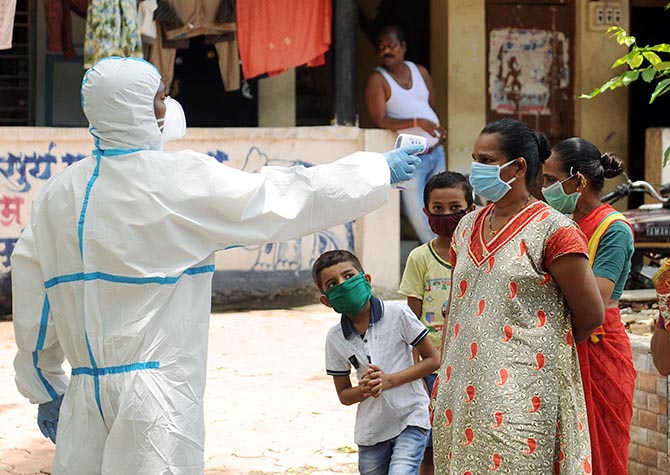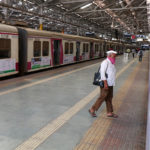‘As people have moved from cities to small towns and villages, they have carried the infection into new territories.’
‘Poor healthcare infrastructure in these places should be a big worry in the days to come.’
IMAGE: Healthcare workers conduct a COVID-19 test in Dharavi, Mumbai, June 9, 2020. Photograph: ANI Photo
Human viruses have been a lifelong study for Dr Shahid Jameel.
After earning degrees in chemistry from Aligarh Muslim University and IIT-Kanpur, he gravitated to the field of virology.
Dr Jameel completed his postdoctoral work in molecular virology at the University of Colorado Health Sciences Center, Denver, USA, and returned to India to set up the virology group at the International Centre for Genetic Engineering and Biotechnology, New Delhi, in 1988. He headed this group for 25 years.
This virologist is presently the CEO of the India-based DBT/Wellcome Trust India Alliance; an appointment he has held since 2013.
“Maharashtra has it really tough because of import of cases, being the business and manufacturing hub, and most importantly, high population density, especially in Mumbai,” Dr Jameel tells Vaihayasi Pande Daniel/KhabriBaba.com in the concluding part of the interview.
IMAGE: Healthcare workers walk through Dharavi, Mumbai, June 7, 2020. Photograph: Francis Mascarenhas/Reuters
When COVID-19 first came to India, we had some preliminary information on the nature of the virus, but knowledge was limited or sketchy.
What is some of the most critical, newer information, about it?
How now, six months into its existence in its form that is infective to humans, does COVID-19’s deadliness rate compared to the flu or TB etc?
Never in the history of infectious disease have we learned so much about it in such a short period of time.
Within three to four months of its discovery, we have over 130 vaccines against SARS-CoV-2 in development.
Multiple repurposed drugs are being tested across the world.
We know about the structures of key proteins and enzymes made by the virus, which allows us to develop drugs and vaccines.
Over 46,000 viral genome sequences from across the world are openly available for scientists to understand where the virus came from and how it is evolving.
Almost 6,500 research papers are openly available on pre-print servers, and most paid journals have also made their COVID-19 research openly available.
All this has created a wealth of knowledge in a very short time.
COVID-19 is about five to 10 times more deadly than common flu.
It cannot be compared to TB since that is a bacterial disease and more importantly people become chronic carriers, sometimes for life.
In 2018, the world saw about 1.5 million TB deaths.
IMAGE: Commuters inside a BEST bus after some restrictions were lifted in Mumbai, June 8, 2020. Photograph: Francis Mascarenhas/Reuters
As a resident of Mumbai in lockdown, taking the standard precautions against the virus, it is unlikely I have encountered COVID-19, hopefully.
But there seem to be limitless safeguards one must keep in mind to protect yourself against it.
There is still a lot that is unknown about the virus and that makes our daily living highly difficult.
Where can one get more exact information on how much to wash items coming into your home?
The most important interventions at this time are masks, hand hygiene and physical distancing.
If everyone wears a mask, it drastically cuts down transmission.
The virus is also very sensitive to soap and to alcohol-based sanitisers.
Studies have shown that SARS-CoV-2 can stay on surfaces from 4 to 72 hours at room temperature.
An effective and affordable way to clean surfaces is to use a 1:100 dilution of fabric bleach.
It will be viable longer at cold temperatures in the fridge or freezer, and that is why proper disinfection is needed for things that go in there.
Experiments have not been done at 60 degrees C but at 70 degrees C and that kills the virus in five minutes; greater than 90 degrees C would kill it in seconds.
IMAGE: A trader counts currency notes at a market in Kochi. Photograph: Sivaram V/Reuters
In post-lockdown days, what are the most important precautions to take when one goes out?
We know a lot of the standard ones, like masks, washing hands, social distancing.
What are some of the lesser known precautions?
Follow the standard precautions properly and you would do well.
Most people don’t pay attention to currency notes. But when you think about it, they circulate more widely than most things.
Sanitise currency notes.
Do you think the lockdown in India has been successful?
I would say partially successful.
It could have been more successful if it was better planned and evidence-based scientific advice was followed.
Though the numbers vary, but various models have shown that the lockdown saved lives, which was expected.
It also slowed down the outbreak from a doubling time of 5 to 6 days at the start to about 14 days at the end of lockdown.
But the numbers of cases and deaths continued to rise — from 657 cases and 12 deaths at the start to over 180,000 cases and over 5,000 deaths at the end.
That is why from a public health perspective it was only partially successful.
Popular opinion is that cases have risen even though we are under lockdown.
Why has that occurred?
And now when community transmission has indeed begun the lockdown is lifting?
Places like Bihar, UP and Jharkhand will harvest thousands of cases in the coming days, if movements of people are no longer tracked and they are not subjected to 14 day quarantine, as the Bihar government recently announced.
It is not popular opinion, but data, as I quote above.
There are a variety of reasons why the lockdown did not work as well as it should have.
These reasons are both medical and socioeconomic, including planning and implementation.
But I feel most importantly it was poor communication and policy implementation, which left a lot of people vulnerable and uncertain of their future.
The next meal is a more real challenge than an invisible virus and this led to poor public health compliance.
As people have moved from cities to small towns and villages, they have carried the infection into new territories.
Poor healthcare infrastructure in these places should be a big worry in the days to come.
IMAGE: Healthcare workers in Dharavi, Mumbai, June 8, 2020. Photograph: ANI Photo
After 80 plus days, India has had enough both psychologically and financially of this lockdown.
And a lifting would be logical.
But how can a lifting occur without a significant volume of testing?
And how can there be control in crowded living areas, that were having difficulty coping even during lockdown?
The lockdown had run its course and was giving diminishing returns.
For example, over the past three weeks the doubling time for cases has remained largely unchanged, when it should have steadily increased.
The challenge now is how to resume economic activity without an exponential growth in cases.
Testing is a key to identify clusters and isolate them.
Areas of high population density, like urban slums would continue to pose another challenge.
There is every possibility that the outbreak will speed up, so extreme care is required now.
It is very important for India to test and while the ratio of tests per million population is rising, it seems testing in rural areas and smaller cities is very low and there is little knowledge of the spread there.
This is definitely a challenge.
When you look at the whole national scenario, in relation to the control of the spread of COVID-19 in the country, what are some of the things being done right or going right?
And what are some of the things being done wrong or going wrong?
Kerala and Karnataka are two states that have done well.
What is common between them is that public health experts are calling the shots and managing the outbreak.
Kerala was the first to get infected cases and it managed to level off the outbreak using a combination of tough public health measures and economic support to vulnerable people.
Its transparency and clear communication built a level of trust missing from rest of the country.
And Maharashtra, where the government is beng guided a medical task force as well?
I don’t know to what extent Maharashtra is doing it, so unable to comment.
Much has been written about Kerala and their health minister, and I personally know some people on the Karnataka Task Force, who are very competent. Perhaps Maharashtra is doing it too.
But let me say that Maharashtra has it really tough because of import of cases, being the business and manufacturing hub (and therefore lots of people coming in and out) and, most importantly, high population density, especially in Mumbai.
Unlike many other states, Maharashtra is very transparent with its daily data.
That is very welcome and builds trust in their sincerity to deal with the pandemic.
Production: Ashish Narsale/KhabriBaba.com




